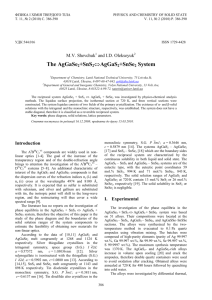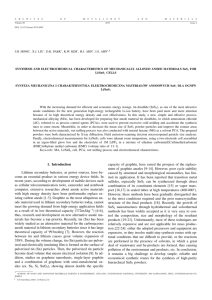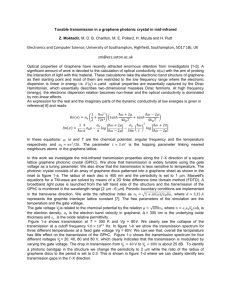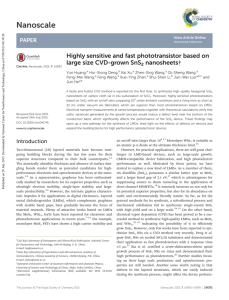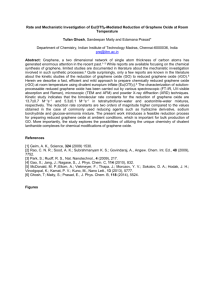Supplementary Material_07 July 2014_L14-04357
advertisement
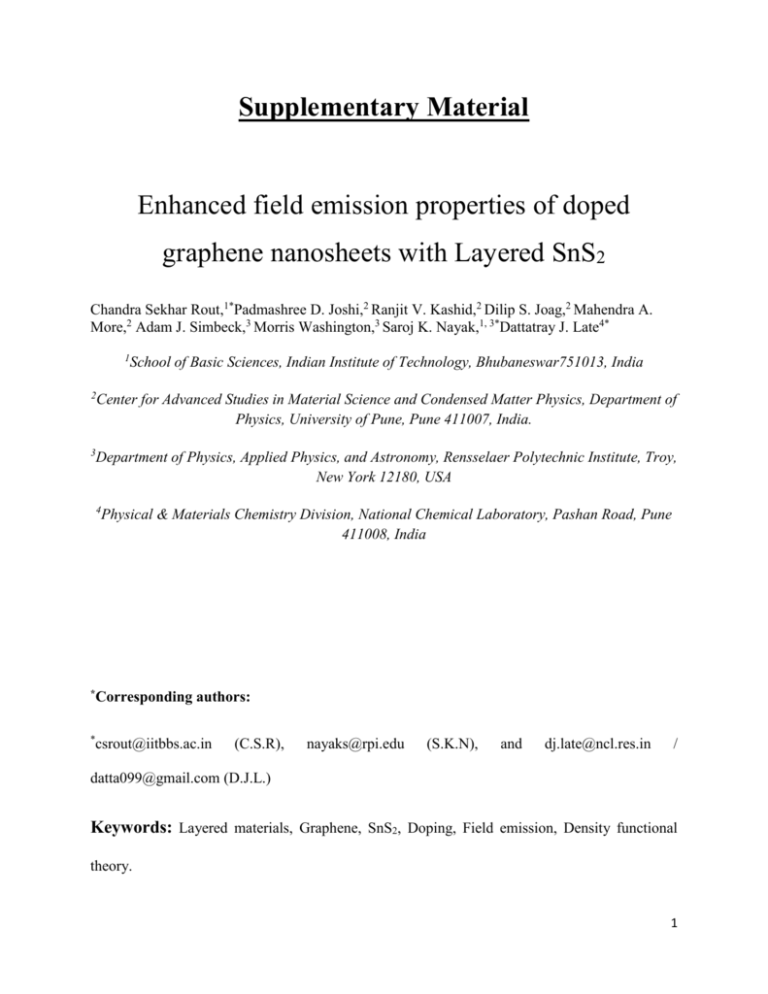
Supplementary Material Enhanced field emission properties of doped graphene nanosheets with Layered SnS2 Chandra Sekhar Rout,1*Padmashree D. Joshi,2 Ranjit V. Kashid,2 Dilip S. Joag,2 Mahendra A. More,2 Adam J. Simbeck,3 Morris Washington,3 Saroj K. Nayak,1, 3*Dattatray J. Late4* 1 2 3 School of Basic Sciences, Indian Institute of Technology, Bhubaneswar751013, India Center for Advanced Studies in Material Science and Condensed Matter Physics, Department of Physics, University of Pune, Pune 411007, India. Department of Physics, Applied Physics, and Astronomy, Rensselaer Polytechnic Institute, Troy, New York 12180, USA 4 Physical & Materials Chemistry Division, National Chemical Laboratory, Pashan Road, Pune 411008, India *Corresponding * authors: csrout@iitbbs.ac.in (C.S.R), nayaks@rpi.edu (S.K.N), and dj.late@ncl.res.in / datta099@gmail.com (D.J.L.) Keywords: Layered materials, Graphene, SnS2, Doping, Field emission, Density functional theory. 1 EXPERIMENTAL METHODS (a) Preparation of SnS2 sheets: SnS2 sheets were synthesized by a one-step hydrothermal reaction. In a typical reaction process, 3 mMNa2SnO3.3H2O (Sigma-aldrich, 99%) and 15 mM thioacetamide (C2H5NS, Sigma-Aldrich, ≥ 99%)were dissolved in 40 mL DI water and stirred for 1 hour at room temperature by using a magnetic stirrer. The solution was transferred to a 50 mL stainless steel autoclave, heated up to 200⁰C, and kept for 24 hours. After cooling naturally, the product was filtered, washed with DI water, and dried in vacuum at 60⁰C for 6 hours. (b) Preparation of SnS2/RGO composites: The SnS2/RGO composite was synthesized by the same hydrothermal reaction condition as that forSnS2nanosheets. 8 mL of 5 mg/mL GO solution was added to the mixture of Na2SnO3.3H2O and thioacetamide, and the total volume of the solution was maintained at 40 mL. The same processes mentioned for the SnS2 sheets were followed. The GO solution synthesis was performed by a modified Hummer’s method as reported earlier.1,2-4 (c) Characterizations: The samples were characterized with X-ray diffraction [XRD (Rigaku, Minislex model)] equipped with the following: Ni filtered Cu K radiation (40 kV, 100 mA, λ= 0.15418 nm), scanning electron microscopy [SEM (FEI ESEM QUANTA 200 3D)], and high resolution transmission electron microscopy [HRTEM (FEI TECNAI TF-30)]. The samples were also characterized by a Micro Raman spectrometer (Lab RAM HR Raman microscope) with a laser excitation wavelength of 514.5 nm and laser power of 1 mW. 2 (d) Field emission: The field emission studies of few-layered SnS2nanosheetsand the SnS2/RGO nanocomposite were investigated independently in an ultra-high vacuum (UHV) chamber at the base pressure of ~1x10-8 mbar as described earlier.1 A modified F-N equation31,32 is used for the analysis of field emission current density versus applied electric field data from the F-N plot for SnS2 and SnS2/RGO composite. The modified F-N equation is as follows, 𝐽 = 𝜆𝑀 𝑎𝜑 𝑏𝜑 3⁄2 𝐸 𝛽 𝑒𝑥𝑝 (− 𝑣 ) 𝛽𝐸 𝐹 −1 2 2 … (1) Where, λM macroscopic pre-exponential correction factor, J is the current density, E is the applied average electric field (surface field), a and b are constants (a = 1.54×10-6 AeV/V2, b = 6.83 eV-3/2Vnm-1), 𝜑 is the work funtion of the emitter, is the field enhancement factor, and υF (correction factor) is a particular value of the principal Schottky-Nordheim barrier function υ. The field enhancement factor is calculated from the slope (m) of F-N plot and work function (𝜑) of emitter (calculated from DFT which is discussed below), using following equation, 𝛽= (−6.8 × 103 )𝜑3⁄2 𝑚 (2) COMPUTATIONAL METHODS To model the SnS2/RGO structure, free-standing SnS2, free-standing graphene, and a SnS2/graphene composite system were considered (Figure 5) within first-principles density DFT.3,4 The DFT based Vienna abintio simulation package (VASP)7-10 was employed with the projector-augmented wave (PAW)11,12 method to describe the electron-ion interaction. The 3 exchange-correlation energy is described using the local density approximation (LDA).13 For SnS2 (graphene) a plane-wave basis energy cutoff of 350 eV (600 eV), a 12×12×1 (18×18×1) Γcentered k-point grid, and at least 10 Å of vacuum was necessary to see convergence in the total energy on the order of 1 meV per unit cell. Furthermore, the partial occupancies of the orbitals were described using the tetrahedral smearing method. For the SnS2/graphene composite system a 12×12×1 k-point sampling was employed and at least 20 Å of vacuum is included. The geometry and cell parameters were fully optimized for the SnS2 unit cell using the conjugate gradient method where the total energy convergence threshold was10-4 eV and the maximum force allowed on any atom was 0.01 eV/Å. The unit cells of each two-dimensional (2D) structure were then multiplied and combined to form the composite supercell: 2×2 for SnS2 and 3×3 for graphene, resulting in a total of 30 atoms (4 Sn, 8 S, and 18 C). In addition, the graphene cell was compressively strained by 1.6% in order to match-up the lattice constants of the two layers. The electronic character of graphene was preserved under this small amount of strain, consistent with the literature,14 i.e. the Dirac cone is preserved and no gap is opened up, hence graphene remains semi-metallic. No further lattice mismatch or rotational considerations were taken into account for the supercell. Lastly, in order to account for spurious dipole interactions between periodic images, dipole corrections wereconsidered,15 but such corrections were found to be small (less than 1 meV per atom). The previous set of parameters and basic methodology has proven to be reliable in past theoretical studies of metal dichalcogenide-graphene composites.1 4 References 1 C. S. Rout, P. D. Joshi, R. V. Kashid, D. S. Joag, M. A. More, A. J. Simbeck, M. Washington, S. K. Nayak and D. J. Late, Sci. Rep. 3, 3282 (2013). 2 S. Ratha, C.S. Rout, ACS Appl. Mater. Interf. 5, 11427 (2013). 3 M. Thripuranthaka D. J. Late, ACS Appl. Mater. Interf.6, 1158 (2014). 4 M. Thripuranthaka, R. V. Kashid, C. S. Rout D. J. Late, Appl. Phys. Lett.104, 081911 (2014). 5 W. Kohn and L.J. Sham, Phys. Rev.140, 1133 (1965). 6 P. Hohenberg and W. Kohn, Phys. Rev. B 136, B864 (1964). 7 G. Kresse and J. Furthmuller,Comput. Mater. Sci.6, 15 (1996). 8 G. KresseandJ. Furthmuller, Phys. Rev. B54, 11169 (1996). 9 G. Kresse and J. Hafner, Phys. Rev. B47, 558 (1993). 10 G. Kresse and J. Hafner, Phys. Rev. B49, 14251 (1994). 11 P.E. Blöchl, Phys. Rev. B50, 17953 (1994). 12 G. KresseandD. Joubert, Phys. Rev. B59, 1758 (1999). 13 J.P. Perdew and A. Zunger, Phys. Rev. B23, 5048 (1981). 14 S. M. Choi, S.H. Jhi, and Y.W. Son, Phys. Rev. B81, 081407 (2010). 15 J. Neugebauer and M. Scheffler, Phys. Rev. B46, 16067 (1992). 5 400 200 0 498 495 492 489 486.55 486 Sn 3d 483 480 Binding energy (eV) 161.6 S 2p 3/2 Binding energy (eV) 168 Sn 3d5/2 494.98 Sn 3d3/2 Intensity (a.u) C 1s S 2s S 2p 600 Sn 4d Sn 3p 800 S 2p 162.7 S 2p 1/2 Intensity (a.u) 1000 Sn 3s Intensity (a.u) Sn 3d Figure S1: XPS spectra of SnS2 166 164 162 160 158 Binding energy (eV) 6 400 200 162 486.5 Sn 3d5/2 492 489 486 483 480 C 1s S 2p C 1s Intensity (a.u) 161.5 S 2p 3/2 164 495 Binding energy (eV) 162.6 S 2p 1/2 Intensity (a.u) 166 494.9 498 0 Binding energy (eV) 168 Sn 3d3/2 Intensity (a.u) C 1s S 2s S 2p 600 Sn 4d Sn 3p 800 Sn 3d 284.5 1000 Sn 3s Intensity (a.u) Sn 3d Figure S2: XPS spectra of SnS2/RGO 160 Binding energy (eV) 158 294 292 290 288 286 284 282 280 Binding energy (eV) 7 Brief background of Research work on field emission investigations of Layered SnS2: Graphene and its analogous layered materials have received tremendous attention of researchers for their potential applications in energy storage, energy conversion, catalytic activity and sensing devices.1-4 Attributed to the versatile coordination characteristics of tin (Sn) and sulfur (S), SnS2 nanomaterials can exist in one-dimension (1D) chains to two-dimension (2D) sheets and even three-dimension (3D) open frameworks and discrete molecular species.5-8 Oxidation states of tin may vary from +4 to +2 and -2, -1, and 0 for sulfur. Various possible local coordination geometries around the tin center vary from trigonal pyramidal to tetrahedral, trigonal-bipyramidal and octahedral. In addition the geometry around sulfur can vary from terminal, v-shaped to trigonal pyramidal.5-8 Depending upon the oxidation state, SnS2 exist in two types of structures namely SnS and SnS2, which feature either close-packing or an open structure decorated by regular arrays.5 The SnS2 commonly referred to as mosaic gold, is a layered material with a peculiar Cadmium iodide (CdI2)-type (trigonal-1T) structure with a pseudo-hexagonal unit cell (a = 0.36486 and c = 0.58992 nm) consisting of a S-Sn-S triple layer, in which the individual triple layers are held together by the van der Waals interactions.7 The SnS2 layer can be viewed as composed of all-edge sharing octahedral SnS6 building units with the sulfur atoms exhibiting three-fold coordination and local trigonal-pyramidal symmetry.5 The SnS2 layered materials has attracted considerable attention in recent years because of their visible band-gap of 2.2-2.35 eV, as well as being nontoxic, inexpensive and chemically stable compound.5-7 Due to their superior electrochemical properties and high surface area, SnS2 nanosheets9,10 and their composites with carbon nanotubes11 and graphene12,13 have been widely investigated for Li-ion battery application. The high surface area and high percentage of 8 disordered surface atoms in chemically synthesized SnS2 nanosheets has enabled them to act as visible-light driven photocatalysts,6,14 high response photodetector, gas sensors and other optoelectronic nanodevices.14-16 Also, SnS2 nanosheet membranes have recently been employed for fabricating field-effect transistors and other logic devices.17,18 SnS2 with its wide range of applications to technology has even been fascinated as a possible cold cathode material. Field electron emission is the ejection of electrons by quantum mechanical tunneling from a conducting/semiconducting emitter upon application of a very high field (~10 6V/cm). In view of their applicability as cold cathodes, metallic emitters are known for their inherent tendency to deliver high current densities whereas semiconductors are known for stable operation in the saturation regime. Reports on various semiconducting field emitters exhibit comparatively lower current densities though (due to limited conductivity); hence, researchers are trying to explore field emission characteristics from other superior semiconducting field emitters. Recently efforts have been put forward by various groups for improving the electrical conductivity by preparing metal-semiconductor composites.19 Researchers are now interested in exploring the field emission properties of 2D nanostructures due to their planar structure, which is ideal for flat/planar device technology such as electron sources in flat panel displays. Layered materials like graphene,19-23 its composites24 and RGO25 are well established 2D field emission cathodes and have potential application in field emission based cathodes. Promising field emission properties of 3D MoS2 nanoflowers like morphology and few layer MoS2 nanosheets has also been reported.26 We have recently reported field emission studies on WS2 and a WS2/RGO composite.27 The study revealed that WS2/RGO nanocomposites show superior field emission performance in comparison with their semiconducting counterparts due to overlapping 9 of structure.27 This study has inspired us to further investigate field emission performance in different chalcogenides and their composite with RGO. 10
